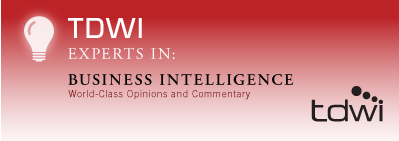


| EDUCATION |
|
TDWI Business Intelligence Fundamentals:
From Data Warehousing to Business Impact TDWI Project Management for Business
Intelligence Power, Politics, and Partnership in
Business Intelligence Projects |
| WHITE PAPERS | |
|
| WEBINARS | ||||||||||||||||||
|
||||||||||||||||||
| ABOUT TDWI EXPERTS |
TDWI Experts is a twice-monthly e-newsletter where BI/DW thought leaders share opinions and commentary about relevant industry topics and the latest technologies. |


May 19
BI: The End of the Beginning
David Stodder
Director of TDWI Research
for Business Intelligence
Topic: Experts in BI
Today, few would dispute that business intelligence (BI) has arrived. Most surveys show that BI is at or near the top of the priority list for most organizations. The future points to even more BI; data is everywhere, and it is increasingly imperative for executives, managers, and frontline workers to have the ability to access, analyze, and report on it. Yet, IT organizations that believe that they have "delivered" BI and can rest on their laurels will find themselves in a rear-guard action, with most of their energies spent protecting budgets, looking for ways to trim costs, and trying to manage and placate dissatisfied users who are reaching out for other solutions on their own.
BI has reached a certain pinnacle in terms of its presence, but now cannot be the end for BI. To paraphrase Winston Churchill, this must be the end of the beginning. With technology options shifting and business objectives with information becoming more aggressive, there's no better time for organizations to refresh their approach to BI and data warehousing and validate their current direction. This is the theme of the next TDWI World Conference, coming up June 6-10 in Chicago.
BI tools have been evolving for over two decades now, from early routines designed to automate SQL programming to packages that combine data access, reporting, analysis, visualization, and more. To some organizations, therein lies the problem: there's too much stuffed into enterprise BI packages, making them expensive and complicated to deploy. This has created a market opening for tools that are easier to deploy and that emphasize dashboard visualizations that can be customized by nontechnical people. The burgeoning "data discovery" market puts greater focus on giving users unified views and access to multiple types of data, including unstructured, rather than just one or a few sources in carefully managed reports tailored to explicit roles in a corporate hierarchy.
As users adopt mobile smartphones and tablets, the data discovery market opening could widen. Frontline sales and service employees want to use mobile devices so they can have single views of all customer information, for example, while they are in the field interacting with customers and business partners. In other business processes, it is becoming clear to managers that poor information flow contributes to higher costs and delays in supply chains, product development, logistics, and more. If organizations can use BI and/or data discovery tools, perhaps on mobile devices, to improve the delivery, sharing, and analysis of data throughout operational business processes, the benefits could go right to the bottom line.
Sponsored Links |
Outcomes and Optimization: Information-Driven Objectives
Along with these shifts in technology platforms and user expectations, businesses are adjusting their strategic objectives to derive more value out of information assets. To assess progress toward goals for improving business outcomes and optimizing business processes, organizations need to base metrics on good data and sharper analysis of variables that affect such goals. If a company wants to set goals for higher profit margins or creating a more desirable mix of customers, it will need to realign reports, metrics, data visualizations, and analysis to help personnel focus on these goals rather than simply give them standard, voluminous reports that deliver a pile of data.
Objectives for particular business outcomes are usually set at a strategic level and require collaboration across departments. BI systems need to facilitate such collaboration; organizations should validate whether their current data integration, metadata, master data management, and data warehousing systems are up to the challenge of cross-functional collaboration, and address any obstacles.
BI and analytics are vital to process optimization, where organizations are looking for how they can increase efficiency by improving their allocation of labor and other resources, work more effectively with supply chain partners and distributors, and more. If organizations can optimize processes -- and put relevant and timely information into the hands of those accountable for doing so -- they can have more control over factors that affect business agility. They can also have visibility into the impact that events outside their control might have, such as earthquakes and floods. They can use analytics to predict the impact of these variables and become more proactive in setting up contingency plans.
Thus, in most organizations, BI is at the end of the beginning, not at the beginning of the end of its evolution. To move forward, however, organizations need to embrace and adapt to changes in technology and in the role information plays in strategic objectives. If organizations stand pat, they risk letting BI systems become impediments that make it harder, not easier for organizations to achieve goals that depend on continuously refining how information is used. Too much has been achieved to let that happen.
David Stodder is director of research for business intelligence at TDWI. David can be reached at [email protected]
David Stodder is director of research for business intelligence at TDWI. David can be reached at [email protected].

